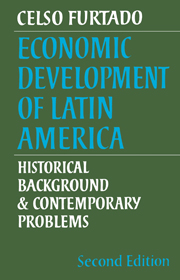Book contents
- Frontmatter
- Contents
- Tables
- Preface to the second edition
- Preface to the first edition
- Abbreviations
- Maps
- PART ONE FROM THE CONQUEST TO THE FORMATION OF NATION-STATES
- PART TWO ENTRY INTO THE SYSTEM OF INTERNATIONAL DIVISION OF LABOUR
- PART THREE THE TRADITIONAL STRUCTURAL PATTERN
- PART FOUR CHARACTERISTICS OF THE INDUSTRIALISATION PROCESS
- PART FIVE REORIENTATION OF DEVELOPMENT IN THE RECENT PERIOD
- 13 Evolution of macroeconomic structures
- 14 Agricultural sector
- 15 Industrial sector
- 16 Inadequate growth and the reorientation of development
- PART SIX INTERNATIONAL RELATIONS
- PART SEVEN INTRA-REGIONAL RELATIONS
- PART EIGHT STRUCTURAL RECONSTRUCTION POLICIES
- Bibliography
- Index
13 - Evolution of macroeconomic structures
Published online by Cambridge University Press: 25 January 2010
- Frontmatter
- Contents
- Tables
- Preface to the second edition
- Preface to the first edition
- Abbreviations
- Maps
- PART ONE FROM THE CONQUEST TO THE FORMATION OF NATION-STATES
- PART TWO ENTRY INTO THE SYSTEM OF INTERNATIONAL DIVISION OF LABOUR
- PART THREE THE TRADITIONAL STRUCTURAL PATTERN
- PART FOUR CHARACTERISTICS OF THE INDUSTRIALISATION PROCESS
- PART FIVE REORIENTATION OF DEVELOPMENT IN THE RECENT PERIOD
- 13 Evolution of macroeconomic structures
- 14 Agricultural sector
- 15 Industrial sector
- 16 Inadequate growth and the reorientation of development
- PART SIX INTERNATIONAL RELATIONS
- PART SEVEN INTRA-REGIONAL RELATIONS
- PART EIGHT STRUCTURAL RECONSTRUCTION POLICIES
- Bibliography
- Index
Summary
Diversity in behaviour patterns
A comparative analysis of overall development trends in the post-war period reveals wide differences in the stages at which the Latin American countries find themselves, and at the same time makes it possible to establish the broad outline of a representative model for the regional economy. For the purpose of this analysis we have used data covering the period starting in 1950 for the countries of greatest relative economic importance in the region: Argentina, Brazil, Chile, Colombia, Mexico, Peru and Venezuela. All these countries have experienced significant structural economic change during the period under review, as can be seen from the figures given in Tables 13.1 and 13.2. In all of them, the agricultural sector's share in the gross domestic product has decreased: between 1950 and 1970 it declined from 18.7 to 13.8 per cent in Argentina; from 22.5 to 12.2 per cent in Mexico; from 39.8 to 29.7 per cent in Colombia and from 27.4 to 19.1 per cent in Peru. By contrast, manufacturing increased considerably in every one of these countries. In Brazil, the share of the manufacturing sector in GDP was slightly over half that of the agricultural sector in 1950; two decades later it was 36 per cent more than that of agriculture. In Argentina the share of manufacturing in GDP is two and a half times that of agriculture and in Mexico it is nearly double the figure for agriculture.
- Type
- Chapter
- Information
- Economic Development of Latin AmericaHistorical Background and Contemporary Problems, pp. 131 - 140Publisher: Cambridge University PressPrint publication year: 1977



